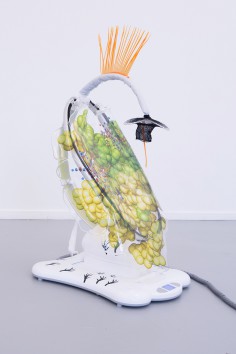KATJA NOVITSKOVA
爱沙尼亚艺术家 柏林个展
A DAY IN A LIFE

source: we-find-wildness
While I’m sure almost all of you have heard of KATJA NOVITSKOVA, best known for her large animals cut-outs digitally printed on aluminum plates, she recently created a series of moving sculptures assembled from products found in DIY stores, pharmacies or on childcare websites among others.
As in her previous works, KATJA NOVITSKOVA explores notions of spatiality, materiality as well as the capacity for visitors to be affected by images or in this case by everyday items through cute and strange characters. For the first time, the Dutch-Estonian artist has composed moving pieces which at times invite, at times rebuff interaction, with each state a point of departure for other trajectories in the exhibition space.
The video above is part of the documentation of the exhibition that she presented on the occasion of OPEN 2014 in November 2014 at the Rijkakademie where she was artist resident from beginning 2013 to the end of 2014.
.
.
.
.
.
.
.
source: bardedu
Katja Novitskova (b. 1984) is an artist and curator born in Tallin, Estonia and currently based in Amsterdam. In her project “Post Internet Survival Guide” (2010), Novitskova and her collaborators collectively gathered images and texts from the Internet to create a book that does not lament the powerless state of the image but rather attempts to “interpret and index this ocean of signs” in order to present us with strategies of “survival.” From 2008–2010 she studied at the Sandberg Instituut in Amsterdam in the Graphic Design department. Recent exhibitions and curatorial initiatives include: (group exhibition) Mawu-Lisa, New Gallery London, London, UK; (group exhibition) Oggetto Soggetto, Centro de Arte 2 de Mayo, Madrid, Spain; (curated project) Post Internet Survival Guide, Future Gallery and Gentili Apri, Berlin; and (curated exhibition) TruEYE surView, W139, Amsterdam.
.
.
.
.
.
.
.
source: ensemblesmhkabe
Leeft in Amsterdam (Netherlands), geboren in Estonia.
Katja Novitskova heeft het in haar werk over het kijken naar de hemel vanuit haar raam in een hoogbouw in een buitenwijk van Tallinn, waar de inwoners gebukt gaan onder een negatief imago. Net als de sterren in haar telescoop, horen die ‘Russisch-sprekenden’ niet helemaal thuis op de plek waar ze terecht zijn gekomen; anderen zagen hen niet meer zoals ze zelf dachten te zijn, of misschien waren ze nog niet wat ze nog zouden kunnen worden. Na de politisering van de identiteit in het Estland van de jaren 1990 te hebben ervaren, zocht Novitskova naar manieren om daaraan te ontsnappen, die echter ook, onvermijdelijk, manieren bleken die toegang gaven tot iets anders: autodidactische astronomie, academische semiotiek, grafisch ontwerp en de meer dubieuze maar ook meer toepasselijke kennis verworven door iemand die gebruik maakt van het internet om kunstenaar te worden.
“Post Internet Survival Guide 2010 is in hoofdstukken opgedeeld volgens de eerste pagina van de zoekresultaten voor ‘survival guide’ op Google: SCHAT DE SITUATIE IN, GEBRUIK AL JE ZINTUIGEN, ONTHOUD WAAR JE BENT, SCHAT LEVEN NAAR WAARDE, IMPROVISEER, OVERWIN ANGST EN PANIEK, GEDRAAG JE ZOALS DE LOKALE BEWONERS, LEER BASISVAARDIGHEDEN.” Een manifest dat zo goed is als een ander, met het extra voordeel dat het simultaan ook een objet trouvé is, of misschien eerder een objet recherché. Het boek dat Novitskova’s reputatie als vooruitstrevende ‘digital native’ heeft bevestigd, verdient te worden beschouwd als een nuttige eerste kennismaking met het hedendaagse leven.
Het zou simplistisch zijn te veronderstellen dat de post-internet kunst (een term die haar boek heeft weten te introduceren) ernaar streeft om bevrijd te worden uit zijn natuurlijke habitat, of zichzelf ziet als de ‘na’ die deze tentoonstelling zich toe-eigent. Novitskova’s werk wordt echter gekenmerkt door een sterke interesse in het organische en de verschillende domeinen van de natuur. Beelden van dieren en planten spelen een dermate prominente rol, vooral in haar installaties, dat het soms verleidelijk is om te veronderstellen dat hun hightech mediëring een excuus is voor het feit dat ze in het werk worden opgenomen, in plaats van andersom. Waarom zou ze anders zoveel aandacht besteden aan ze er zo belangeloos willekeurig te laten uitzien? (AK)

